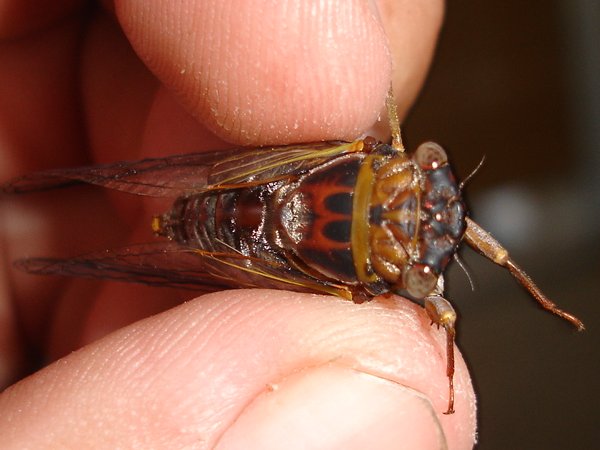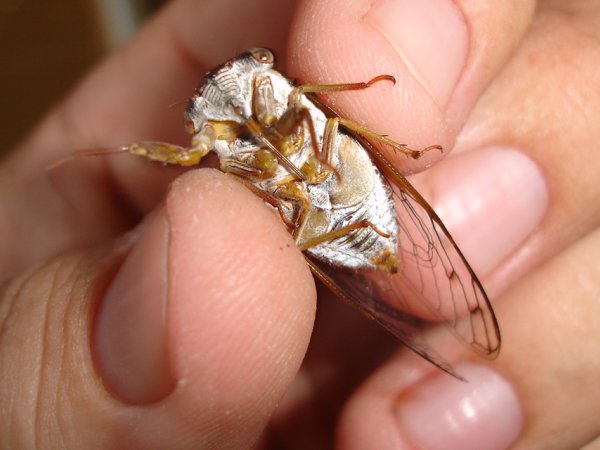Diceroprocta olympusa (Walker, 1850) aka Olympic Scrub Cicada.

Photo by Joe Green.

Photo by Joe Green.
See all Diceroprocta olympusa photos & information on cicadamania.com.
Song type: Call
Source: ©Insect Singers | Species: D. olympusa
Song type: Starting Call
Source: ©Joe Green | Species: D. olympusa
Song type: Chorus
Source: ©Joe Green | Species: D. olympusa
Song type: Distress
Source: ©Joe Green | Species: D. olympusa
Video
Video Playlist
Playlists contain multiple videos found on YouTube.
Name, Location and Description
- Cicada Name: Diceroprocta olympusa (Walker, 1850)
- Short Name: D. olympusa
- Common Name: Olympic Scrub Cicada
- Former Names & Synonyms: Cicada olympusa Walker, Cicada sordidata Uhler, Cicada milvus Walker.
- When: June-August. Peaks in August.
- Where it is found: AL, FL, GA, MS, NC, SC
- Maps: Biogeography of the Cicadas (Hemiptera: Cicadidae) of North America, North of Mexico [PDF]
- Description: Black, brown and green with white pruinose.
- Eye Color: brown?
- Pronotal Collar Color: green to brown
- Identification: Bug Guide
- Identification: iNaturalist
- Taxonomic Information: Integrated Taxonomic Information System
- Song: Insect Singers
Descriptions from Wm. T. Davis’s NOTES ON CICADAS FROM THE UNITED STATES WITH DESCRIPTIONS OF SEVERAL NEW SPECIES.1
Note: Diceroprocta olympusa (Walker, 1850) = Cicada sordidata Uhler, 1892 & Cicada milvus Walker, 1858, in case that isn’t clear. 🙂
Cicada sordidata Uhler, was described in the Transactions of the Maryland Academy of Sciences, 1892, p. 175, from two males from Southern Florida. We figure a male from Big Pine Key, Fla., Sept. 19, 1913, that has been compared with one marked ” S. Fla.” in Uhler’s collection in the United States Nat. Museum, and labeled in his handwriting” Cicada sordidata.” This was no doubt one of his types. His published description is very full and among other things he says that the first three apical areoles of the fore wings “including the veins and cross veins smoke-brown.” This is subject to some variation, though the first and second cross veins are always clouded in mature specimens. He says ” Opercula short, pale, but little more than one-third the length of the abdomen, narrowing toward the tip, and rounded there ; the tips widely separated by a wedge-shaped space ; the drums completely covered by an inflated segent, with a wide interval between, which is occupied at the outer end by a smooth hump. The raised smooth line thus begun is con- tinued back upon the succeeding tergal segments, and from each prominence a grooved line extends outwards to the border of the segments.”
Cicada olympusa Walker was described in 1850, but no locality was given. It has been credited to North America by Distant. The description would seem to cover Cicada sordidata which is of the same size and we have been unable to find any other species in collections that fits it so well. Walker says in part ” scutcheon of the fore-chest [prothorax] adorned with four black stripes; the middle pair long, widened on the fore border and on the hind border ; the outer pair short and slightly curved; furrows and sides blackish; hind scutcheon [hind margin or collar] green, widened, rounded and adorned with a large pitchy mark at the base of each fore-wing, nearly straight on each side : scutcheon of the middle chest [mesonotum] adorned with four obconical black stripes; inner pair short with tawny borders; outer pair much longer, excavated into eight separate parts ; a large black spot with a black dot on each side be- tween the inner pair and the cross-ridge . . . fore borders of the [abdominal] segments adorned with pitchy interrupted bands; overduct ferruginous : drums pale tawny, very small, far apart ; inner sides pitchy.”
If it is meant that the extremities of the opercula are far apart then the above description agrees with sordidata, in which, however, the upper and inner edges of the opercula touch or nearly so.
Cicada milvus was described by Walker in 1858 from a single female from the ” United States ” and has been placed by Distant as a synonym of Cicada olympusa. Walker describes milvus as reddish tawny and says in part : ” Prothorax with four black stripes, the inner pair approximate, connected by a short black band in front, the outer pair very near the borders; two black discal dots; hind border greenish. Mesothorax with four conical black stripes, the inner pair short, the outer pair much intersected. Abdomen with an interrupted black band on each segment. Wings vitreous; veins pale green, black towards the tips. Fore wings with the first and second transverse veins clouded with dark brown.” The wings are said to expand 27 lines, that is about 57 mm.
Classification:
Family: Cicadidae
Subfamily: Cicadinae
Tribe: Cryptotympanini
Subtribe: Cryptotympanina
Genus: Diceroprocta
Species: Diceroprocta olympusa (Walker, 1850)
List of sources
- (1) Davis, W.T. 1916. NOTES ON CICADAS FROM THE UNITED STATES WITH DESCRIPTIONS OF SEVERAL
NEW SPECIES. Journal of the New York Entomological Society. Vol. X?ilV, No. I. Read it on archive.org. - Full Binomial Names: ITIS.gov
- Common names: BugGuide.net; The Songs of Insects by Lang Elliott and Wil Herschberger; personal memory.
- Locations: Biogeography of the Cicadas (Hemiptera: Cicadidae) of North America, North of Mexico by Allen F. Sanborn and Polly K. Phillips.
- Descriptions, Colors: personal observations from specimens or photos from many sources. Descriptions are not perfect, but may be helpful.
Notes:
- Some descriptions are based on aged specimens which have lost some or a lot of their color.